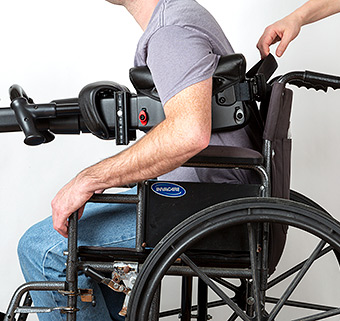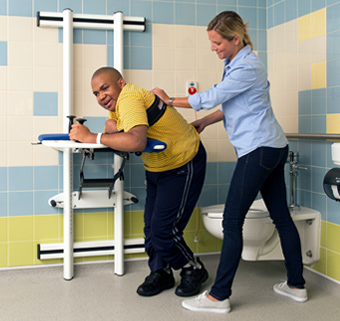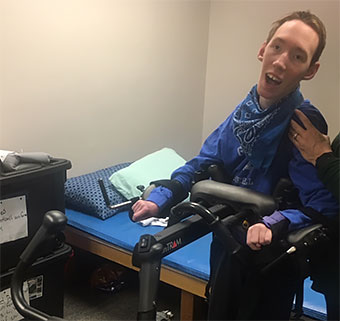Unlikely Funding Source for Adaptive Equipment in Ohio
A Blueprint for other States
| May 2019 Employer work-place injury within schools may sound unlikely, but for those health professionals routinely assisting students with disabilities in school, it is not uncommon. In fact, the injury rate of health professionals engaging in lifts, transfers and re-positioning of patients ranks equally with those working in heavy construction settings.1,2
Employer work-place injury within schools may sound unlikely, but for those health professionals routinely assisting students with disabilities in school, it is not uncommon. In fact, the injury rate of health professionals engaging in lifts, transfers and re-positioning of patients ranks equally with those working in heavy construction settings.1,2
For this reason, in June of 2018, when the Ohio Bureau of Workers’ Compensation launched their safety intervention grant, monies were allocated to the Employers Working with Persons with Disabilities Program (EWPDD). This program provides financial assistance for the purchase of equipment and training to ensure the safety of those providing services for children and adults with disabilities in state-funded environments. Eligible equipment for this grant includes lifts and transfer devices, ambulation devices and bathing and toileting chairs. Over the last year, funding from this grant covered the purchase of Rifton TRAMs as well as Rifton Hygiene and Toileting Systems (HTS) for schools and assisted living facilities.
A Great Success Story
Although they didn’t wish to publicize their name, a central-Ohio school district recently contacted us with an example of how these funds made a big difference. A physical therapist there told how he frequently encountered difficulty assisting his students into gait trainers for ambulation practice. Some of his students required a three-person transfer and it was not uncommon to lack the necessary staff. Because of this, he would sometimes have to forgo the child’s gait training opportunity. As ambulation is a key to health, mobility and educational accessibility, he was therefore on the look-out for a device that could make the transfer process safer and easier. The TRAM appeared to be a great fit, offering zero-lift transfers and supported ambulation all in the same device.
An application for the Ohio BWC Safety Intervention Grant and a few months later, the TRAM arrived. In his words: “The TRAM is everything we hoped it would be – a real game-changer for the students.”
Future Possibilities
Because of the unusually high injury rate of those caring for people with disabilities, Ohio certainly leads the way in preempting injuries and ensuring the safety of the most vulnerable. As research confirms, investing in safe patient handling procedures and equipment is beneficial across the board – less injury, lower workers’ compensation costs, fewer employee days absent and the increased comfort and safety of the patients themselves.3-11 But more importantly, providing appropriate adaptive equipment provides children and adults with disabilities the opportunities to be adequately cared for and frequently mobile. If you know of a similar program in your state, please let me know. We’d like to highlight it here.
See the TRAM here:
References
1. Darragh AR, Huddleston W, King P. Work-related musculoskeletal injuries and disorders among occupational and physical therapists. Am J Occup Ther. 2009; 63(3):351-62.
2. Darragh AR, Campo M, King P. Work-related activities associated with injury in occupational and physical therapists. Work. 2012; 42(3):373-84.
3. Collins JW, Wolf L, Bell J, Evanoff B. An evaluation of a "best practices" musculoskeletal injury prevention program in nursing homes. Inj Prev. 2004; 10:206-11.
4. Garg A, Owen BD. Reducing back stress to nursing personnel: an ergonomic intervention in a nursing home. Ergonomics.1992;35(11):1353–75.
5. Garg, A. Long–term effectiveness of "Zero–Lift Program" in seven nursing homes and one hospital. 1999. Contract Report No. U60/CCU512089–02, University of Wisconsin–Milwaukee. Milwaukee, WI: University of Wisconsin–Milwaukee.
6. Garg A, Kapellusch JM. Long-term efficacy of an ergonomics program that includes patient-handling devices on reducing musculoskeletal injuries to nursing personnel. Hum Factors. 2012;54(4):608-25.
7. Zhuang Z, Stobbe TJ, Hsiao H, Collins JW, Hobbs GR. Biomechanical evaluation of assistive devices for transferring residents. Appl Ergon. 1999; 30(4):285-94.
8. Stenger K, Montgomery LA, Briesemeister E. Creating a culture of change through implementation of a safe patient handling program. Criti Care Nurs Clin North Am. 2007; 19(2):213-22.
9. Knibbe NE, Hanneke J, Knibbe J, Crist J. Special approaches for safe handling of disabled children in The Netherlands. Rehabil Nurs. 2008;33(1):18-21.
10. Motacki K, Motacki LM. Safe patient handling and movement in a pediatric setting. Ped Nurs. 2009; 35(4):221-25.
11. Haglund K, Kyle J, Finkelstein M. Pediatric safe patient handling. J Ped Nurs. 2009; 25(2):98-107.




